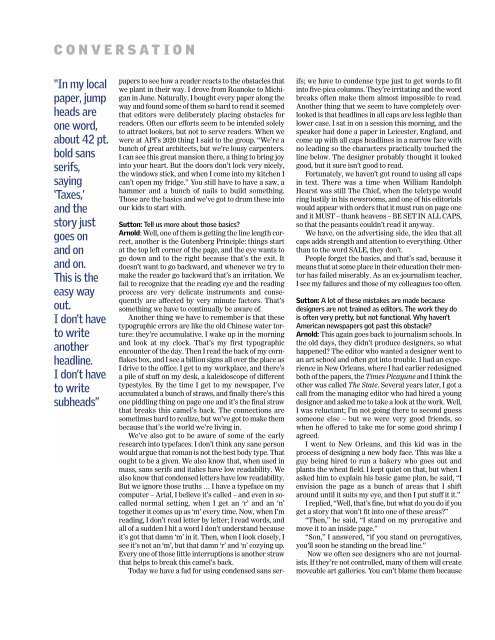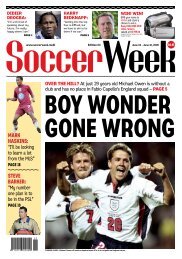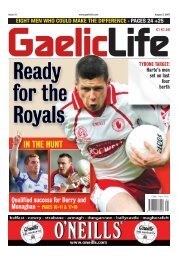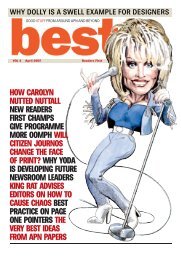Getting Back to Basics with Ed Arnold. - News Design Associates
Getting Back to Basics with Ed Arnold. - News Design Associates
Getting Back to Basics with Ed Arnold. - News Design Associates
- No tags were found...
Create successful ePaper yourself
Turn your PDF publications into a flip-book with our unique Google optimized e-Paper software.
CONVERSATION“In my localpaper, jumpheads areone word,about 42 pt.bold sansserifs,saying‘Taxes,’and thes<strong>to</strong>ry justgoes onand onand on.This is theeasy wayout.I don’t have<strong>to</strong> writeanotherheadline.I don’t have<strong>to</strong> writesubheads”papers <strong>to</strong> see how a reader reacts <strong>to</strong> the obstacles thatwe plant in their way. I drove from Roanoke <strong>to</strong> Michiganin June. Naturally, I bought every paper along theway and found some of them so hard <strong>to</strong> read it seemedthat edi<strong>to</strong>rs were deliberately placing obstacles forreaders. Often our efforts seem <strong>to</strong> be intended solely<strong>to</strong> attract lookers, but not <strong>to</strong> serve readers. When wewere at API’s 2020 thing I said <strong>to</strong> the group, “We’re abunch of great architects, but we’re lousy carpenters.I can see this great mansion there, a thing <strong>to</strong> bring joyin<strong>to</strong> your heart. But the doors don’t lock very nicely,the windows stick, and when I come in<strong>to</strong> my kitchen Ican’t open my fridge.” You still have <strong>to</strong> have a saw, ahammer and a bunch of nails <strong>to</strong> build something.Those are the basics and we’ve got <strong>to</strong> drum these in<strong>to</strong>our kids <strong>to</strong> start <strong>with</strong>.Sut<strong>to</strong>n: Tell us more about those basics?<strong>Arnold</strong>: Well, one of them is getting the line length correct,another is the Gutenberg Principle: things startat the <strong>to</strong>p left corner of the page, and the eye wants <strong>to</strong>go down and <strong>to</strong> the right because that’s the exit. Itdoesn’t want <strong>to</strong> go backward, and whenever we try <strong>to</strong>make the reader go backward that’s an irritation. Wefail <strong>to</strong> recognize that the reading eye and the readingprocess are very delicate instruments and consequentlyare affected by very minute fac<strong>to</strong>rs. That’ssomething we have <strong>to</strong> continually be aware of.Another thing we have <strong>to</strong> remember is that thesetypographic errors are like the old Chinese water <strong>to</strong>rture:they’re accumulative. I wake up in the morningand look at my clock. That’s my first typographicencounter of the day. Then I read the back of my cornflakesbox, and I see a billion signs all over the place asI drive <strong>to</strong> the office. I get <strong>to</strong> my workplace, and there’sa pile of stuff on my desk, a kaleidoscope of differenttypestyles. By the time I get <strong>to</strong> my newspaper, I’veaccumulated a bunch of straws, and finally there’s thisone piddling thing on page one and it’s the final strawthat breaks this camel’s back. The connections aresometimes hard <strong>to</strong> realize, but we’ve got <strong>to</strong> make thembecause that’s the world we’re living in.We’ve also got <strong>to</strong> be aware of some of the earlyresearch in<strong>to</strong> typefaces. I don’t think any sane personwould argue that roman is not the best body type. Tha<strong>to</strong>ught <strong>to</strong> be a given. We also know that, when used inmass, sans serifs and italics have low readability. Wealso know that condensed letters have low readability.But we ignore those truths … I have a typeface on mycomputer – Arial, I believe it’s called – and even in socallednormal setting, when I get an ‘r’ and an ‘n’<strong>to</strong>gether it comes up as ‘m’ every time. Now, when I’mreading, I don’t read letter by letter; I read words, andall of a sudden I hit a word I don’t understand becauseit’s got that damn ‘m’ in it. Then, when I look closely, Isee it’s not an ‘m’, but that damn ‘r’ and ‘n’ cozying up.Every one of those little interruptions is another strawthat helps <strong>to</strong> break this camel’s back.Today we have a fad for using condensed sans serifs;we have <strong>to</strong> condense type just <strong>to</strong> get words <strong>to</strong> fitin<strong>to</strong> five-pica columns. They’re irritating and the wordbreaks often make them almost impossible <strong>to</strong> read.Another thing that we seem <strong>to</strong> have completely overlookedis that headlines in all caps are less legible thanlower case. I sat in on a session this morning, and thespeaker had done a paper in Leicester, England, andcome up <strong>with</strong> all caps headlines in a narrow face <strong>with</strong>no leading so the characters practically <strong>to</strong>uched theline below. The designer probably thought it lookedgood, but it sure isn’t good <strong>to</strong> read.Fortunately, we haven’t got round <strong>to</strong> using all capsin text. There was a time when William RandolphHearst was still The Chief, when the teletype wouldring lustily in his newsrooms, and one of his edi<strong>to</strong>rialswould appear <strong>with</strong> orders that it must run on page oneand it MUST – thank heavens – BE SET IN ALL CAPS,so that the peasants couldn’t read it anyway.We have, on the advertising side, the idea that allcaps adds strength and attention <strong>to</strong> everything. Otherthan <strong>to</strong> the word SALE, they don’t.People forget the basics, and that’s sad, because itmeans that at some place in their education their men<strong>to</strong>rhas failed miserably. As an ex-journalism teacher,I see my failures and those of my colleagues <strong>to</strong>o often.Sut<strong>to</strong>n: A lot of these mistakes are made becausedesigners are not trained as edi<strong>to</strong>rs. The work they dois often very pretty, but not functional. Why haven’tAmerican newspapers got past this obstacle?<strong>Arnold</strong>: This again goes back <strong>to</strong> journalism schools. Inthe old days, they didn’t produce designers, so whathappened? The edi<strong>to</strong>r who wanted a designer went <strong>to</strong>an art school and often got in<strong>to</strong> trouble. I had an experiencein New Orleans, where I had earlier redesignedboth of the papers, the Times Picayune and I think theother was called The State. Several years later, I got acall from the managing edi<strong>to</strong>r who had hired a youngdesigner and asked me <strong>to</strong> take a look at the work. Well,I was reluctant; I’m not going there <strong>to</strong> second guesssomeone else – but we were very good friends, sowhen he offered <strong>to</strong> take me for some good shrimp Iagreed.I went <strong>to</strong> New Orleans, and this kid was in theprocess of designing a new body face. This was like aguy being hired <strong>to</strong> run a bakery who goes out andplants the wheat field. I kept quiet on that, but when Iasked him <strong>to</strong> explain his basic game plan, he said, “Ienvision the page as a bunch of areas that I shiftaround until it suits my eye, and then I put stuff it it.”I replied, “Well, that’s fine, but what do you do if youget a s<strong>to</strong>ry that won’t fit in<strong>to</strong> one of these areas?”“Then,” he said, “I stand on my prerogative andmove it <strong>to</strong> an inside page.”“Son,” I answered, “if you stand on prerogatives,you’ll soon be standing on the bread line.”Now we often see designers who are not journalists.If they’re not controlled, many of them will createmoveable art galleries. You can’t blame them because







